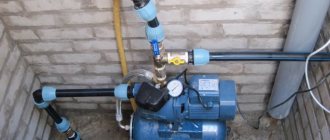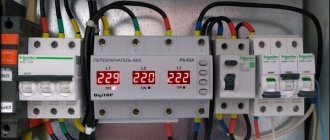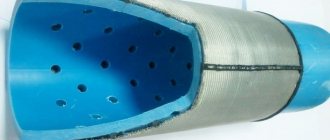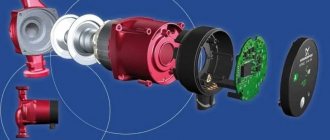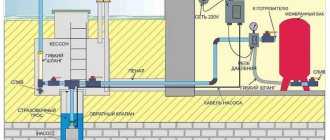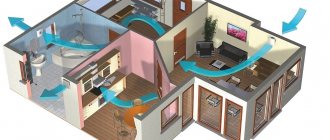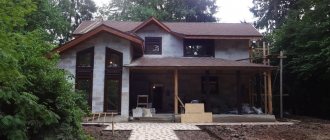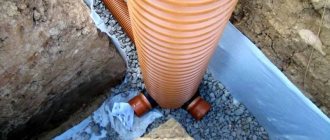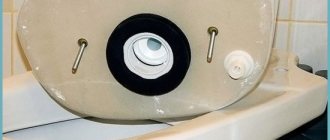The operation of any sewer system is based on the laws of physics. Used water moves under the influence of gravity along the risers, enters storage tanks, and then is discharged into the general pipeline. The uninterrupted operation of such a system is due to the correct slope of the pipes and the requirements for the length and angle of inclination of the underwater pipes.
Despite the simplicity and functionality of gravity sewerage, there is only one, but very significant drawback. These are difficulties when remodeling premises and placing plumbing fixtures. In such systems, water can only move downwards, so it will not be possible to allocate the basement of a private house for a sauna or laundry: you will need to build an additional septic tank, which is not always advisable.
In these cases, the optimal solution to the problem would be to install Sololift2 Grundfos sewerage pumping units. Such systems forcefully drain water in the direction desired by the home owner.
A few words about Sololift markings
When choosing a pumping unit, you need to pay attention to the product labeling. This nuance determines the installation location, functionality and everyday tasks that can be solved using the equipment.
The manufacturer uses capital letters of the Latin alphabet to label products. It looks like this:
- WC – these models have a built-in grinding mechanism. The station is designed for the removal of black (fecal) waste and can be connected to floor-mounted toilets.
- CWC - this category of equipment is also equipped with a grinder and is designed for the removal of fecal waste. However, such models are designed for wall-hung toilets.
- C and D – pumps for removing gray (fecal-free) wastewater, suitable for any plumbing fixtures except toilets.
In addition, the marking of each product includes a numerical designation: 1-3 .
This indicates the number of additional outlets in addition to the main drain. Essentially, the numbers indicate the number of plumbing fixtures connected to the pump.
Design features
The operating principle of Sololift sewerage installations is quite simple. The model is used as the main receiver for wastewater; secondary outlets are connected using auxiliary pipes with a diameter of 5 cm, which are located in the lower sector. Input lines for drains can be implemented using equipment for a standard sewer network, and the outlet elements used to drain liquid must be reliably sealed, since pumping is performed under pressure. That is why during installation it is important to purchase branded components, including a check valve and other elements of plumbing fittings.
The housing contains the pump itself with a separator element and knives that grind large waste. The principle of operation is the operation of an automatic unit, which turns on when the tank is filled and activates the pump; the device is connected to a standard electrical outlet. Energy consumption even for younger models is small, so installing pumping equipment allows you to install an efficient sewer network in a private house or apartment.
How does the drainage system work?
Sololift2 Grundfos sewage pumping stations are equipped with an electric motor and a liquid level sensor. In addition, the structure is made of composite tanks, the storage tank has spherical walls, and the bottom is inclined in the direction of the pump.
This design and layout option minimizes the likelihood of sediment forming on the bottom and walls of the tank. The sensor ensures that the engine turns on only when necessary, which saves energy.
The principle of operation of pumping stations is as follows: wastewater flows into the tank and reaches the control level. The sensor gives the engine a start command, and the liquid is pumped into the public sewer system. When the level drops to the set values, the motor turns off and the pump stops working.
Application area
Depending on the marking and purpose, Sololift2 Grundfos pumping units are used for pumping out black and gray wastewater in rooms where it is impossible to use gravity sewerage. In addition, the equipment is ideal for draining water in bathrooms located below the sewer level.
If we talk about connected elements, the pumps are suitable for the following types of plumbing equipment:
- Baths.
- Wall-hung and floor-mounted toilets.
- Bidet.
- Showers.
- Sinks and washbasins.
- Washing machines.
Thanks to their compact dimensions, pumping stations are built into wall and floor structures, and therefore do not spoil the interior.
About pumping stations intended for water supply, read the article about the series of equipment from Grundfos >>>
Types of compact sewage pumping units
Currently, Sololift Grundfos products are represented by 5 models . Pumping stations with the following markings are suitable for installation in bathrooms:
Pumping unit Sololift2 WC-1 for pumping wastewater from washbasins and toilets
Pumping unit with a power of 620 W, a liquid reservoir of 9 liters. The model is standardly equipped with a chopper and has a throughput capacity of 149 l/min. In addition to the main plumbing fixture (floor-standing toilet), it can be connected to a sink or urinal at the user’s choice.
| Net weight | 7.3 kg |
| Tank capacity | 9.0 l |
| Flexible pressure pipe | ∅22/25/28/32/36/40 |
| Connection to toilet | Toilet with horizontal outlet according to EN 33 or EN 37. The toilet flush must be at least 4 liters. |
| Possible entrance dimensions | 1 x ∅ 32/36/40 |
| Start and stop levels | Launch: 72 mm above floor level Stop: 52 mm above floor level |
| pH value of the pumped liquid | from 4 to 10 |
| Maximum fluid temperature | 50°C |
| Ambient temperature | from +5 °C to +35 °C |
| Operating mode | S3-50% - 1 min. (30 sec. on; 30 sec. off) |
| Supply voltage | 1 x 220-240V - 10%/+ 6%, 50 Hz |
| Power consumption | Max. 620 W |
| Rated current | 3.0 A |
| Power factor | 0,87/0,92 |
| Rotation frequency | 2800 min-1 |
| Protection class | IP44 |
| Insulation class | F |
Automatic sewage pumping installation Sololift2 WC-3 for private homes
An exact analogue of the previous model, but here, in addition to the floor-standing toilet, you can connect a choice of three additional elements: sink, bidet, shower cabin, urinal.
| Net weight | 7.3 kg |
| Tank capacity | 9.0 l |
| Flexible pressure pipe | ∅22/25/28/32/36/40 |
| Connection to toilet | Toilet with horizontal outlet according to EN 33 or EN 37. The toilet flush must be at least 4 liters. |
| Possible entrance dimensions | 1 x ∅ 32/36/40, top connection 2 x ∅ 36/40/50, side |
| Start and stop levels | Launch: 72 mm above floor level Stop: 52 mm above floor level |
| pH value of the pumped liquid | from 4 to 10 |
| Maximum fluid temperature | 50°C |
| Ambient temperature | from +5 °C to +35 °C |
| Operating mode | S3-50% - 1 min. (30 sec. on; 30 sec. off) |
| Supply voltage | 1 x 220-240V - 10%/+ 6%, 50 Hz |
| Power consumption | Max. 620 W |
| Rated current | 3.0 A |
| Power factor | 0,87/0,92 |
| Rotation frequency | 2800 min-1 |
| Protection class | IP44 |
| Insulation class | F |
Sewage pumping unit with built-in professional cutting mechanism Sololift2 CWC-3
Pumping station, power 620 W and capacity 137 l/min. The model is designed to be connected to a wall-mounted toilet, making it possible to connect 3 additional elements: a washbasin, a shower stall, and a bidet or urinal.
| Net weight | 7.1 kg |
| Tank capacity | 9.0 l |
| Flexible pressure pipe | ∅22/25/28/32/36/40 |
| Connection to toilet | Toilet with horizontal outlet according to EN 33 or EN 37. The toilet flush must be at least 4 liters. |
| Possible entrance dimensions | 1 x ∅ 32/36/40, top connection 2 x ∅ 36/40/50, side |
| Start and stop levels | Launch: 72 mm above floor level Stop: 52 mm above floor level |
| pH value of the pumped liquid | from 4 to 10 |
| Maximum fluid temperature | 50°C |
| Ambient temperature | from +5 °C to +35 °C |
| Operating mode | S3-50% - 1 min. (30 sec. on; 30 sec. off) |
| Supply voltage | 1 x 220-240V - 10%/+ 6%, 50 Hz |
| Power consumption | Max. 620 W |
| Rated current | 3.0 A |
| Power factor | 0,87/0,92 |
| Rotation frequency | 2800 min-1 |
| Protection class | IP44 |
| Insulation class | F |
The following models are suitable for draining gray waste:
Compact and ready-to-install sewage pumping unit Sololift2 C-3.
Installation with a power of 640 W, capacity of 204 l/min . There is no chopper here, but the following devices can be connected: sink, bath, shower, bidet, dishwasher and washing machine.
It should be noted that, unlike other models, this station is suitable for draining water whose temperature varies between 75-90 degrees.
| Net weight | 6.6 kg |
| Tank capacity | 5.7 l |
| Flexible pressure pipe | ∅22/25/28/32/36/40 |
| Possible entrance dimensions | 1 x ∅ 32/36/40, top connection 2 x ∅ 36/40/50, side |
| Start and stop levels | Launch level 1: 65 mm above floor level Launch level 2: 115 mm above floor level Stop level: 35mm above floor level |
| pH value of the pumped liquid | from 4 to 10 |
| Maximum fluid temperature | 75 °C constant 90°C for 30 minutes |
| Ambient temperature | from +5 °C to +35 °C |
| Operating mode | S3-50% - 1 min. (30 sec. on; 30 sec. off) |
| Supply voltage | 1 x 220-240V - 10%/+ 6%, 50 Hz |
| Power consumption | Max. 640 W |
| Rated current | 3.1 A |
| Power factor | 0,66/0,90 |
| Rotation frequency | 2800 min-1 |
| Protection class | IP44 |
| Insulation class | F |
Automatic sewage pumping unit Sololift2 D-2
The lightest model in the series, designed for washbasins, showers and bidets. Here the output power is 280 W , the throughput is 119 l/min.
It should be noted that pumping units for toilets have a storage tank size of 9 liters . Equipment weight: 7.3-7.1 kg . Equipment for gray waste has more modest parameters: tank – 5.7/2 l, weight – 6.6/4.3 kg. The data is given in order of listing.
| Net weight | 4.3 kg |
| Tank capacity | 2.0 l |
| Flexible pressure pipe | ∅22/32 |
| Possible entrance dimensions | 2 x ∅32/36/40 side |
| Start and stop levels | Launch level: 58 mm above floor level Stop level: 35mm above floor level |
| pH value of the pumped liquid | from 4 to 10 |
| Maximum fluid temperature | 50°C |
| Ambient temperature | from +5 °C to +35 °C |
| Operating mode | S3-50% - 1 min. (30 sec. on; 30 sec. off) |
| Supply voltage | 1 x 220-240V - 10%/+ 6%, 50 Hz |
| Power consumption | Max. 280 W |
| Rated current | 1.3 A |
| Power factor | 0,90/0,95 |
| Rotation frequency | 2800 min-1 |
| Protection class | IP44 |
| Insulation class | F |
Advantages and disadvantages
Sololift2 sewage pumping units have a number of undeniable technical advantages. For example:
- High technical characteristics and long-term operation.
- Easy to install.
- Minimum maintenance requirements: the system is self-cleaning.
- Minimum noise level during operation.
- Compact dimensions: ideal solution for small bathrooms.
- Sloped bottom of the storage tank, which minimizes the likelihood of sediment accumulation.
- Withstands high temperatures and pressure.
There are only two significant disadvantages:
- Dependence on uninterrupted power supply.
- Inability to pump large volumes of water.
Sololift2 is a modern solution for arranging sewer systems in country houses. It should be noted that the equipment is practically free of disadvantages, while being sold in an affordable price segment of the market.
Sololift pumps for sewerage: equipment prices and installation recommendations
Grundfos sewerage pumping units cannot be classified as budget units. Moreover, the cost depends not only on the modification and functionality of the device, but also on the pricing policy of the store where the equipment is purchased. The outdated Sololift+ series has already been discontinued. This point also affects the cost of pumps.
Cost of Grundfos pumping equipment:
| Model | Dimensions, mm | price, rub. |
| Average prices Sololift plus | ||
| D-3 | 165x380x217 | 15000 |
| WC-1 | 175x452x346 | 15000 |
| C-3 | 158x493x341 | 20000 |
| WC-3 | 175x441x452 | 22000 |
| CWC-3 | 164x495x538 | 22000 |
| Average prices for Sololift 2 | ||
| D-2 | 165x148x376 | 16800 |
| WC-1 | 176x263x452 | 19900 |
| C-3 | 159x256x444 | 21900 |
| WC-3 | 176x263x453 | 24500 |
| CWC-3 | 165x280x422 | 25300 |
Interesting fact! Some models are capable of transporting liquid through a water main over a distance of up to 100 m.
Recommendations for installation and operation of equipment:
- the minimum distance between the pump and a plumbing fixture or wall is 1 cm;
- The shower stall drain is connected from below and requires additional installation of a filter to protect the unit from hair;
- before starting, the inlet valve is checked to ensure that there is no backflow of liquid;
- It is advisable to use vibration-isolating material that will reduce the noise level;
- pipe joints must be treated with sealants and the reliability of the connections checked;
The connection diagram for Sololift to the sewer is quite simple, but requires certain knowledge of the system itself
- to protect yourself, before performing repairs or maintenance, you must remove the fuse and unplug the pump from the outlet, and you must make sure that there is no possibility of accidental activation;
- pumps are compatible with any types of pipes, including plastic ones.
Sololift pumping units are ideal for organizing a forced sewer system with unlimited possibilities that do not impose restrictions on layout. Owners of small apartments will appreciate this advantage. The equipment does not require much space, is installed with minimal use of tools (all necessary adapters are already included in the kit) and does its job effectively, which affects its cost.
Equipment Maintenance
The design features of Sololift2 units allow for minimal maintenance requirements. In order for the equipment to operate correctly over a long period of time, it is necessary to carry out regular preventative cleaning of the tank. For this purpose, a chemically active component is used - a detergent.
For this procedure, you must complete the following steps:
- Disconnect the device from the power source and remove the top cover.
- Pour in the cleaning agent and wait a while.
- Connect the device and drain the water.
- Run the pump with water several times.
- Install the cover.
The maintenance scheme is quite simple, so it does not require the involvement of specialists.
Sololift repair
- To carry out maintenance, it is necessary to promptly change the carbon filter and clean the unit using a special product in liquid form. The step by step process is as follows:
- Disconnect the installation from the network.
- Remove the top cover.
- Pour the product into the reservoir according to the manufacturer's instructions.
- After the required time, connect the station and drain the liquid.
- Close the lid.
If a fault is detected in the system, you should first disconnect it from the network. Then remove and clean the filter, and then replace it. In the same way, you can perform any repair of the station or contact the service department for help.
